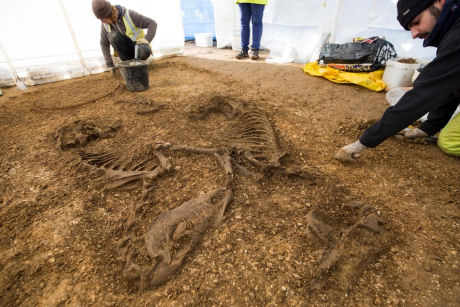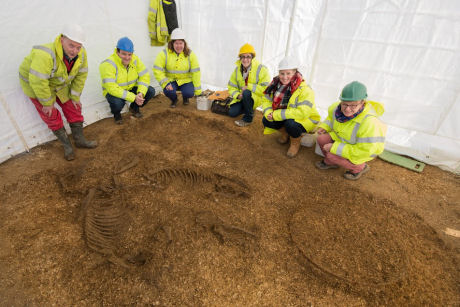|
Final piece of Iron Age puzzle discovered at David Wilson Homes Pocklington site
Two well preserved horse skeletons and the remains of a chariot dating to the Iron Age have been found at The David Wilson Homes’ Pavilion Square development in Pocklington, North Yorkshire.
 The initial phase of archaeological work at the site on Burnby Lane found a large number of Square Barrows containing artefacts including a sword, shield, spears, brooches and pots, dating back as far as 500 BC to 00 AD. David Wilson Homes has worked with MAP Archaeological Practice and the local community to ensure the findings will remain in Pocklington and can be enjoyed by the local community for years to come. The initial phase of archaeological work at the site on Burnby Lane found a large number of Square Barrows containing artefacts including a sword, shield, spears, brooches and pots, dating back as far as 500 BC to 00 AD. David Wilson Homes has worked with MAP Archaeological Practice and the local community to ensure the findings will remain in Pocklington and can be enjoyed by the local community for years to come.
Now, as the housebuilder prepares to launch the second phase of the popular development, the most recent excavation has exposed more details about the rich ancient history of the area, adding further layers to previous findings with analysis expected to reveal more detail on the ritual of death in the Iron Age. The chariot burial is the first example with accompanying horses to be scientifically excavated.
Both excavations have revealed information about British life approximately 2,500 years ago, with the site offering one of the largest and most significant Iron Age findings and insights of recent times into the ‘Arras Culture’. A circular wheel associated in close proximity to the horse skeleton suggests that the animals played a crucial role in the burial ceremony. The chariot was the rare possession of a high status individual, but the deliberate inclusion of the horses as part of the burial rite is highly unusual. Further testing and analysis is expected to reveal more information.
Peter Morris, Development Director at David Wilson Homes, commented:
“The new findings are extremely exciting for the further clarity they bring to understanding Iron Age Britain. We’re delighted that we can play a role in exposing the rich history of this country prior to starting work on construction – we understand the importance of ensuring the findings are removed from site carefully so we can try and preserve these
artefacts. These finds offer a fascinating heritage for the local area, which can help bind communities who come to call this place their home in the future. A study is already underway – set to be the largest of an Iron Age population undertaken in the last 35 years - so the findings will help us to gain a better understanding of the culture and area
at the time.”
 Paula Ware, Managing Director at MAP Archaeological Practice Ltd., added: Paula Ware, Managing Director at MAP Archaeological Practice Ltd., added:
“The chariot was located in the final Square Barrow to be excavated and on the periphery of the cemetery. The chariot at Burnby Lane is only the twenty-sixth one to be excavated in the country and the inclusion of horses raises the significance of the burial. The discoveries are set to widen our understanding of the Arras culture and the dating of artefacts to secure contexts is exceptional. We’ve been working closely with David Wilson Homes to ensure that the site is recorded to it’s full potential. The archive of the excavations and the conservation of the artefacts will preserve the results for the benefit of future generations of academics and researchers. The discovery is an example of what can be revealed and discovered when house developers and archaeologists work together in advance of construction. We look forward to investigating the archaeological significance of the excavation.”
Councillor Stephen Parnaby OBE, leader of East Riding of Yorkshire Council, said: "The finding of a chariot burial site at Burnby Lane, is of international significance and is an example of the rich history of East Yorkshire. The Humber Archaeology Partnership inform us that these types of burials from the Iron Age are mainly found in the East Riding.
"This discovery is really exciting and, as the local planning authority, we would like to place on record our thanks and appreciation to David Wilson Homes for halting their works and allowing experts to study the site in detail and record this for future generations.";
With a major gap in studies into the Iron Age population, the site is of national and international significance, as the discovery may shape historians’ understanding of this period in time. A major focus area of the archaeological analysis will concentrate on the origins of the local Iron Age population, hopefully to show whether they were indigenous or had continental connections.
|

